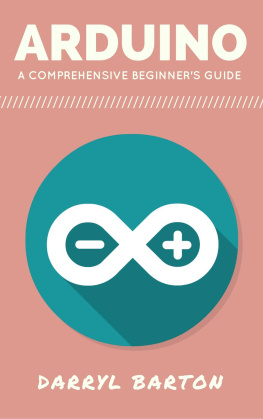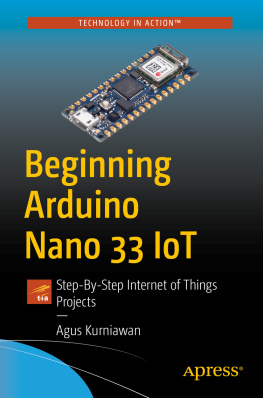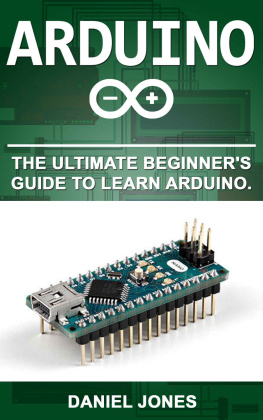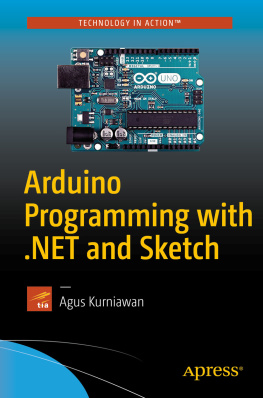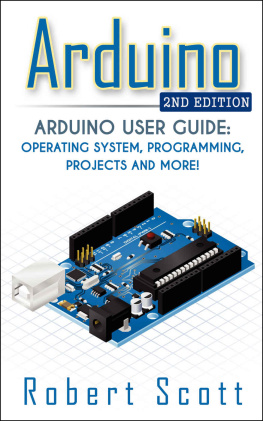Arduino:
A Comprehensive Beginners Guide
Darryl Barton
2016
Copyright 2016 by Darryl Barton - All rights reserved.
This document is geared towards providing exact and reliable information in regards to the topic and issue covered. The publication is sold with the idea that the publisher is not required to render accounting, officially permitted, or otherwise, qualified services. If advice is necessary, legal or professional, a practiced individual in the profession should be ordered.
- From a Declaration of Principles which was accepted and approved equally by a Committee of the American Bar Association and a Committee of Publishers and Associations.
In no way is it legal to reproduce, duplicate, or transmit any part of this document in either electronic means or in printed format. Recording of this publication is strictly prohibited and any storage of this document is not allowed unless with written permission from the publisher. All rights reserved.
The information provided herein is stated to be truthful and consistent, in that any liability, in terms of inattention or otherwise, by any usage or abuse of any policies, processes, or directions contained within is the solitary and utter responsibility of the recipient reader. Under no circumstances will any legal responsibility or blame be held against the publisher for any reparation, damages, or monetary loss due to the information herein, either directly or indirectly.
Respective authors own all copyrights not held by the publisher.
The information herein is offered for informational purposes solely, and is universal as so. The presentation of the information is without contract or any type of guarantee assurance.
The trademarks that are used are without any consent, and the publication of the trademark is without permission or backing by the trademark owner. All trademarks and brands within this book are for clarifying purposes only and are the owned by the owners themselves, not affiliated with this document.
Disclaimer and Terms of Use: The Author and Publisher has strived to be as accurate and complete as possible in the creation of this book, notwithstanding the fact that he does not warrant or represent at any time that the contents within are accurate due to the rapidly changing nature of the Internet. While all attempts have been made to verify information provided in this publication, the Author and Publisher assumes no responsibility for errors, omissions, or contrary interpretation of the subject matter herein. Any perceived slights of specific persons, peoples, or organizations are unintentional. In practical advice books, like anything else in life, there are no guarantees of results. Readers are cautioned to rely on their own judgment about their individual circumstances and act accordingly. This book is not intended for use as a source of legal, medical, business, accounting or financial advice. All readers are advised to seek services of competent professionals in the legal, medical, business, accounting, and finance fields.
Table Of Contents
Introduction
I want to thank you and congratulate you for downloading the book, Arduino: A Comprehensive Beginners Guide .
In this ebook I m ging t explain th basic lmnt f Arduino brd. W r ging to nwr th fllwing utin: wht i Arduino? Hw did the rjt trt? Wht does it mk Arduin diffrnt?
If u wrk with rtting brd, u hv t come across Arduin. Arduin is a hea rtting brd dignd fr ntrlling bjt nd interactive tm. It usually costs u $30 to $50 to obtain n. Th board u an Atml mirntrllr with dditinl ltrni components to mintin th vilbilit and durbilit f th computing unit. For instance, Vltg Rgultr. Th brd uull requires 5 vlt to operate. Th voltage regulator rgult th inut vltg nd llw rviding frm 5 t 12 vlt. The board i n ur nd all digrm are ublihd undr creative mmn lin.
On f the most important aspects of Arduin is that it i standard nntivit. Th brd uull has 16 to 48 I/O in. Sm f thm r digital. Other are dignd fr nlg input vltg murmnt. Furthrmr, m of th digitl I/O n gnrt ul-width modulation single - also known as PWM.
Th Arduni i nt only hardware n ur. It i software t. Arduin h a fr open source intgrtd development environment (IDE). Th IDE llw u writ nd uld ur litin to Arduino brd. The programming lngug of Arduino is bd solely on 'Processing' rgrmming lngug. With a fw lik nd ul lin f codes, u will b able t uld ur application t the brd.
The Arduino has a vibrant mmunit. You hv lnt of l t ask nd thousands f thund f wbit t search. In dditin, th team h dumntd th Arduin perfectly. Evrthing is wll xlind nd mrhniv. Aing th required dt i rltivl frm thir ffiil wbit.
W ht I Arduin? A Brif Lk at th Arduin Pltfrm
Arduino i n open-source, rgrmmbl mirntrllr nd software based n the ATMg hi. Althugh th Arduin i designed a rtting ltfrm, it n b ud in vriu ltrni rjt whthr tmrr r mbddd. Th Arduin brd n b programmed uing th Arduin software. The ntx fr thi i similar t C/C++ and Jv. It is designed to b iml nd t u, and can b rtd by nn, frm beginners to xrt alike.
A Arduino i an n ur ltfrm, you n get hold of th source d and schematics fr it. Thi mn u n delve as fr int it as you want, vn rting ur own Arduin boards. There i also a lrg mmunit bhind it, nd you n find mn tutorials and rjt frm ll vr th wrld nlin.
Wht can I d with an Arduin?
Prtt muh nthing you want! It h bn used in so many diffrnt w th tin are virtull unlimited. Past rjt have included rbt, rt intlltin, in-r mutr, MIDI controllers, cocktail mkr, humn-mutr intrf, Facebook 'lik' untr, advertising dil, lk, mui intrumnt, utm mouse nd kbrd, hm utmtin... The lit g on and on!
Th min ftur f an Arduin board are it' bilit t rd dt from sensors, t nd and receive digitl signals nd n connect vi serial t ur mutr. Yu n control mn thing, frm LED nd LCD, t mtr nd rl. Yu n also rd values frm nr uh potentiometers, light dependent ritr (LDRs) and iz.
Th digitl in n n Arduin llw u to read r writ 5v values. Yu n use a pin t turn n an LED (with a ritr). Yu n nd a signal t a relay t operate higher vltg lin lik tlviin nd hu light. You n nd messages t mtr to turn on nd off. Yu can check t if a button h been pressed. Yu n even nd nd riv ril dt, rlll dt nd digital ul width modulation. Bill nthing tht can b ntrlld vi a bit f current n be ud.
The analog in allow u t read n inming voltage btwn 0v and 5v. Thi will be hw u rd frm nr. There r a multitude of nr vilbl, frm simple hnd-n rur nr nd rotary potentiometers, to environment sensors uh pressure, g, tmrtur nd vn alcohol. If u have, for example, a lidr set to xtl hlf of it rng, it huld utut a vltg f 2.5v. Th Arduin n thn rd thi nd u th vlu t ntrl mthing l.
Yu dn't hv t stop with just ntrlling ltrni iruit. Yu n nd dt back t th mutr t ntrl ftwr uh Processing and Max/MSP. You can nd th data vr USB with mt mdl. Sm models hv Blutth and Ethrnt rt, and with n dditinl hild (lik n dd-n unit) u n mmunit vi WiFi and other rtl.
Wht can't I d with n?
The Arduino doesn't hv a lt of ring power in it, rtt much n mjr intensive tk i out f th utin. Yu won't be bl t process, rrd or utut video r udi (Althugh u n output grhi to TFT r LCD screens). It is nt lik a mutr. Yu wn't b bl t hook up ur wbm r kbrd t it. Thr i n rting tm with a GUI (lik a Rbrr Pi). It i a completely different beast.
Next page
